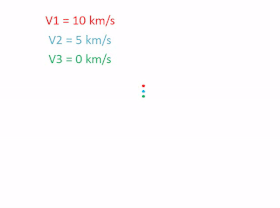- 1,161
- 371
It seems that the regular KE formula KE = 1/2mV^2 Ðüð░n not be used in case of expanding clouds (or any expanding mass for that matter)
The reason for this is that not every piece to cloud travels the same distance in the given timeframe. Clouds near the center of a storm need to travel a shorter distance in the same timeframe so you can see that the velocity is not constant for all mass and therefore regal KE can not be used.


Here's an animation showing that each point of mass of the cloud moves at different velocity. For an average 20 km radius storm that took 2 seconds to fully expand. Mass at the edge the storm is moving at 10 km/s (red point). Blue point in the middle - 5 km/s and green point it the center is not moving at all.
I need to add that the KE formula of expanding mass depends on its shape but since clouds always form a cylinder the KE formula should be KE = mR^2/4t^2. (or just 0.25mV^2)
The reason for this is that not every piece to cloud travels the same distance in the given timeframe. Clouds near the center of a storm need to travel a shorter distance in the same timeframe so you can see that the velocity is not constant for all mass and therefore regal KE can not be used.


Here's an animation showing that each point of mass of the cloud moves at different velocity. For an average 20 km radius storm that took 2 seconds to fully expand. Mass at the edge the storm is moving at 10 km/s (red point). Blue point in the middle - 5 km/s and green point it the center is not moving at all.
I need to add that the KE formula of expanding mass depends on its shape but since clouds always form a cylinder the KE formula should be KE = mR^2/4t^2. (or just 0.25mV^2)
